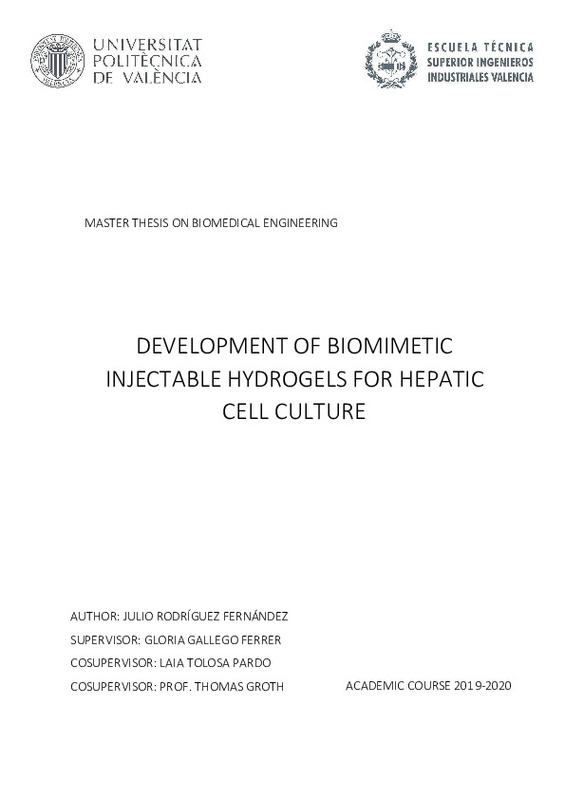JavaScript is disabled for your browser. Some features of this site may not work without it.
Buscar en RiuNet
Listar
Mi cuenta
Estadísticas
Ayuda RiuNet
Admin. UPV
Desarrollo de hidrogeles biomiméticos inyectables para cultivo celular hepático
Mostrar el registro sencillo del ítem
Ficheros en el ítem
| dc.contributor.advisor | Gallego Ferrer, Gloria
|
es_ES |
| dc.contributor.advisor | Tolosa Pardo, Laia
|
es_ES |
| dc.contributor.advisor | Groth, Thomas
|
es_ES |
| dc.contributor.author | Rodríguez Fernández, Julio
|
es_ES |
| dc.date.accessioned | 2021-02-02T16:22:17Z | |
| dc.date.available | 2021-02-02T16:22:17Z | |
| dc.date.created | 2020-07-22 | |
| dc.date.issued | 2021-02-02 | es_ES |
| dc.identifier.uri | http://hdl.handle.net/10251/160535 | |
| dc.description.abstract | [ES] Los métodos de cultivo de células que simulan el tejido, los cuales promueven la función específica del hígado durante un período prolongado, son herramientas prometedoras para la ingeniería de tejidos hepática y los estudios de hepatotoxicidad en el desarrollo de fármacos. Se basan en el uso de biomateriales como plataformas de cultivo celular tridimensionales que intentan recapitular la interacción célula-célula y célula-matriz. Pueden imitar la composición y la rigidez de la matriz extracelular del hígado, mediante la combinación de una proteína y un polisacárido, como una estrategia para promover la funcionalidad hepática de las células cultivadas. Además, si los biomateriales son inyectables, resultan muy ventajosos, ya que permiten la encapsulación homogénea de las células, la escalabilidad del cultivo in vitro mediante bioimpresión y la implantación del constructo biomaterial-células mediante cirugías mínimamente invasivas. El objetivo de trabajo final de máster es el desarrollo de hidrogeles inyectables biomiméticos basados en la combinación de gelatina y ácido hialurónico y dos reacciones químicas de reticulación distintas, para elegir el material óptimo para promover la funcionalidad hepática. La síntesis del hidrogel se optimizará para la correcta reticulación en presencia de células. Los materiales se caracterizarán fisicoquímicamente en busca de una rigidez similar a la del hígado y la liberación controlada de factores de crecimiento hepáticos. Finalmente, los hepatocitos se encapsularán dentro de los hidrogeles y se evaluará los marcadores de funcionalidad hepática a lo largo del cultivo, comparando con cultivos bidimensionales clásicos. La síntesis de hidrogeles se realizará en el Centro de Biomateriales e Ingeniería Tisular de la Universitat Politècnica de València y en colaboración con el profesor Thomas Groth de la Universidad Martin Luther Halle-Wittenberg (donde el estudiante realizó una estancia Erasmus+ en el contexto de su TFM). El cultivo de hepatocitos se llevará a cabo en el Instituto de Investigación de Salud LaFe bajo la supervisión de la Dra. Laia Tolosa. | es_ES |
| dc.description.abstract | [EN] Tissue-mimic cell culture methods, which promote liver-specific function for long period, are promising tools for liver tissue engineering and hepatotoxicity studies in drug development. They are based on the use of biomaterials as three dimensional cell culture platforms that try to recapitulate cell-cell and cell-matrix interaction. They can mimic the composition and stiffness of the liver extracellular matrix, by the combination of a protein and a polysaccharide, as a strategy to promote hepatic functionality of cultured cells. Furthermore, if biomaterials are injectable they result very advantageous, as they allow the homogeneous encapsulation of cells, the scalability of the in vitro culture by bioprinting and the implantation of the cell-biomaterial construct by minimally invasive surgeries. The aim of this Master Thesis is the development of biomimetic injectable hydrogels based on the combination of gelatin and hyaluronic acid and two crosslinking chemistries, in order to choose the optimal material to promote the hepatic functionality. Hydrogel synthesis will be optimized for the correct crosslinking in the presence of cells. The materials will then be physico-chemically characterized looking for liver-like stiffness and sustained release of hepatic growth factors. Finally, hepatocytes will be encapsulated within the hydrogels and their functional markers as hepatocytes will be assessed and compared with the classical two-dimensional cultures. The synthesis of hydrogels will be performed in the Centre for Biomaterials and Tissue Engineering of the Polytechnic University of Valencia and in collaboration with Professor Thomas Groth from the Martin Luther University Halle-Wittenberg (where the student already performed an Erasmus+ stay). Hepatocyte culture will be carried out at the LaFe Health Research Institute under the supervision of Dr. Laia Tolosa. | es_ES |
| dc.format.extent | 108 | es_ES |
| dc.language | Inglés | es_ES |
| dc.publisher | Universitat Politècnica de València | es_ES |
| dc.rights | Reserva de todos los derechos | es_ES |
| dc.subject | Hidrogeles inyectables | es_ES |
| dc.subject | Gelatina | es_ES |
| dc.subject | Ácido hialurónico | es_ES |
| dc.subject | Cultivo celular hepático | es_ES |
| dc.subject | Funcionalidad hepática | es_ES |
| dc.subject | Injectable hydrogels | es_ES |
| dc.subject | Gelatin | es_ES |
| dc.subject | Hyaluronic acid | es_ES |
| dc.subject | Hepatic cell culture | es_ES |
| dc.subject | Hepatic functionality | es_ES |
| dc.subject.classification | MAQUINAS Y MOTORES TERMICOS | es_ES |
| dc.subject.other | Máster Universitario en Ingeniería Biomédica-Màster Universitari en Enginyeria Biomèdica | es_ES |
| dc.title | Desarrollo de hidrogeles biomiméticos inyectables para cultivo celular hepático | es_ES |
| dc.type | Tesis de máster | es_ES |
| dc.rights.accessRights | Abierto | es_ES |
| dc.contributor.affiliation | Universitat Politècnica de València. Departamento de Termodinámica Aplicada - Departament de Termodinàmica Aplicada | es_ES |
| dc.contributor.affiliation | Universitat Politècnica de València. Escuela Técnica Superior de Ingenieros Industriales - Escola Tècnica Superior d'Enginyers Industrials | es_ES |
| dc.description.bibliographicCitation | Rodríguez Fernández, J. (2020). Desarrollo de hidrogeles biomiméticos inyectables para cultivo celular hepático. Universitat Politècnica de València. http://hdl.handle.net/10251/160535 | es_ES |
| dc.description.accrualMethod | TFGM | es_ES |
| dc.relation.pasarela | TFGM\122111 | es_ES |
Este ítem aparece en la(s) siguiente(s) colección(ones)
-
ETSII - Trabajos académicos [10404]
Escuela Técnica Superior de Ingenieros Industriales






